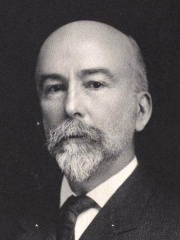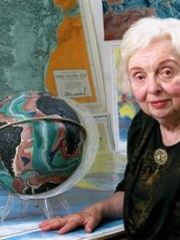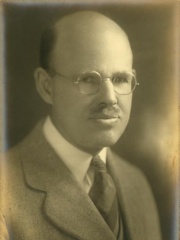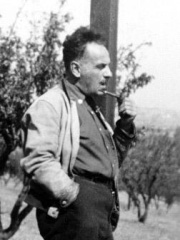





The Most Famous
GEOGRAPHERS from United States
This page contains a list of the greatest American Geographers. The pantheon dataset contains 86 Geographers, 7 of which were born in United States. This makes United States the birth place of the 4th most number of Geographers behind United Kingdom, and France.
Top 7
The following people are considered by Pantheon to be the most legendary American Geographers of all time. This list of famous American Geographers is sorted by HPI (Historical Popularity Index), a metric that aggregates information on a biography's online popularity.

1. William Morris Davis (1850 - 1934)
With an HPI of 68.15, William Morris Davis is the most famous American Geographer. His biography has been translated into 37 different languages on wikipedia.
William Morris Davis (February 12, 1850 – February 5, 1934) was an American geographer, geologist, geomorphologist, and meteorologist, often called the "father of American geography". He was born into a prominent Quaker family in Philadelphia, Pennsylvania, son of Edward M. Davis and Maria Mott Davis (a daughter of the women's advocate Lucretia Mott). Davis studied geology and geography at Harvard's Lawrence Scientific School and then joined the Harvard sponsored geographic exploration party to the Colorado territory, led by the inaugural Sturgis-Hooper professor of geology, Josiah Dwight Whitney. Wild stories had circulated since soon after the Louisiana Purchase about Rocky Mountains peaks 18,000 feet or higher. The Harvard expedition set out to investigate, and found none, but they did find "14ers" (14,000-plus feet). He graduated from Harvard University in 1869 and received a Master of Mining Engineering in the following year. Davis worked for Nathaniel Shaler as a field assistant, and was later hired to teach at Harvard. Though his legacy lives on in geomorphology, he also advanced theories of scientific racism in his writings about physical geography. After his first wife died, Davis married Mary M. Wyman from Cambridge, Massachusetts in 1914, and, after her death, he married Lucy L. Tennant from Milton, Massachusetts in 1928, who survived him. He died in Pasadena, California, shortly before his 84th birthday. His Cambridge home is a National Historic Landmark.

2. Marie Tharp (1920 - 2006)
With an HPI of 62.70, Marie Tharp is the 2nd most famous American Geographer. Her biography has been translated into 29 different languages.
Marie Tharp (July 30, 1920 – August 23, 2006) was an American geologist and oceanographic cartographer. In the 1950s, she collaborated with geologist Bruce Heezen to produce the first scientific map of the Atlantic Ocean floor. Her cartography revealed a more detailed topography and multi-dimensional geographical landscape of the ocean bottom. Tharp's discovery of the Mid-Atlantic Ridge caused a paradigm shift in earth science that led to the acceptance of the theories of plate tectonics and continental drift.

3. Richard Hartshorne (1899 - 1992)
With an HPI of 58.04, Richard Hartshorne is the 3rd most famous American Geographer. His biography has been translated into 19 different languages.
Richard Hartshorne (; December 12, 1899 – November 5, 1992) was a prominent American geographer, and professor at the University of Wisconsin-Madison, who specialized in economic and political geography and the philosophy of geography. He is known in particular for his methodological work The Nature of Geography, published in 1939.

4. Ellsworth Huntington (1876 - 1947)
With an HPI of 57.07, Ellsworth Huntington is the 4th most famous American Geographer. His biography has been translated into 19 different languages.
Ellsworth Huntington (September 16, 1876 – October 17, 1947) was a professor of geography at Yale University during the early 20th century, known for his studies on environmental determinism/climatic determinism, economic growth, and economic geography. He served as president of the Ecological Society of America in 1917, the Association of American Geographers in 1923 and president of the board of directors of the American Eugenics Society from 1934 to 1938. He taught at Euphrates College, Turkey (1897–1901); accompanied the Pumpelly (1903) and Barrett (1905–1906) expeditions to central Asia; and wrote of his Asian experiences in Explorations in Turkestan (1905) and The Pulse of Asia (1907). He taught geography at Yale (1907–1915) and from 1917 was a research associate there, devoting his time chiefly to climatic and anthropogeographic studies. He was the 1916 recipient of the Elisha Kent Kane Gold Medal from the Geographical Society of Philadelphia. In 1909, Huntington led the Yale Expedition to Palestine. It was his mission to determine "step by step the process by which geologic structure, topographic form, and the present and past nature of the climate have shaped man's progress, moulded his history; and thus played an incalculable part in the development of a system of thought which could scarcely have arisen under any other physical circumstances." During the Progressive Era, Huntington expressed concern about immigration and the race mixing. He claimed that liberal immigration policy would lead to the "highest racial values" being "irrevocably swamped by those of lower calibre." He was on the original standing committee of the Foundation for the Study of Cycles from 1941.

5. Ellen Churchill Semple (1863 - 1932)
With an HPI of 55.79, Ellen Churchill Semple is the 5th most famous American Geographer. Her biography has been translated into 24 different languages.
Ellen Churchill Semple (January 8, 1863 – May 8, 1932) was an American geographer and the first female president of the Association of American Geographers. She contributed significantly to the early development of the discipline of geography in the United States, particularly studies of human geography. She is most closely associated with work in anthropogeography and environmentalism, and the debate about "environmental determinism".

6. Carl O. Sauer (1889 - 1975)
With an HPI of 55.74, Carl O. Sauer is the 6th most famous American Geographer. His biography has been translated into 18 different languages.
Carl Ortwin Sauer (December 24, 1889 – July 18, 1975) was an American geographer. Sauer was a professor of geography at the University of California at Berkeley from 1923 until becoming professor emeritus in 1957. He has been called "the dean of American historical geography" and he was instrumental in the early development of the geography graduate school at Berkeley. One of his best known works was Agricultural Origins and Dispersals (1952). In 1927, Carl Sauer wrote the article "Recent Developments in Cultural Geography", which considered how cultural landscapes are made up of "the forms superimposed on the physical landscape".

7. Henry Schoolcraft (1793 - 1864)
With an HPI of 49.63, Henry Schoolcraft is the 7th most famous American Geographer. His biography has been translated into 19 different languages.
Henry Rowe Schoolcraft (March 28, 1793 – December 10, 1864) was an American geographer, geologist, and ethnologist, noted for his early studies of Native American cultures, as well as for his 1832 expedition to the source of the Mississippi River. He is also noted for his major six-volume study of Native Americans commissioned by Congress and published in the 1850s. He served as United States Indian agent in Michigan for a period beginning in 1822. During this period, he named several newly organized counties, often creating neologisms that he claimed were derived from indigenous languages. There he married Jane Johnston, daughter of a prominent Scotch-Irish fur trader and an Ojibwe mother, who was the high-ranking daughter of Waubojeeg, a war chief. Jane lived with her family in Sault Ste. Marie, Michigan. She was bilingual and educated, having grown up in a literate household. Jane taught Schoolcraft the Ojibwe language and much about her maternal culture. They had several children together, only two of whom survived past childhood. She is now recognized for her poetry and other writings as the first Native American literary writer in the United States. Schoolcraft continued to study Native American tribes and publish works about them. In 1833, he was elected as a member of the American Philosophical Society. By 1846, Jane had died. That year, Schoolcraft was commissioned by Congress for a major study, known as Indian Tribes of the United States. It was published in six volumes from 1851 to 1857, and illustrated by Seth Eastman, a career Army officer with extensive experience as an artist of indigenous peoples. Schoolcraft remarried in 1847, to Mary Howard, from a slaveholding family in South Carolina. In 1860, Howard published the bestselling novel The Black Gauntlet. It was part of the Anti-Tom literature that was written in Southern response to the bestselling Uncle Tom's Cabin by Northern abolitionist Harriet Beecher Stowe.
People
Pantheon has 7 people classified as American geographers born between 1793 and 1920. Of these 7, none of them are still alive today. The most famous deceased American geographers include William Morris Davis, Marie Tharp, and Richard Hartshorne.
Deceased American Geographers
Go to all RankingsWilliam Morris Davis
1850 - 1934
HPI: 68.15
Marie Tharp
1920 - 2006
HPI: 62.70
Richard Hartshorne
1899 - 1992
HPI: 58.04
Ellsworth Huntington
1876 - 1947
HPI: 57.07
Ellen Churchill Semple
1863 - 1932
HPI: 55.79
Carl O. Sauer
1889 - 1975
HPI: 55.74
Henry Schoolcraft
1793 - 1864
HPI: 49.63
Overlapping Lives
Which Geographers were alive at the same time? This visualization shows the lifespans of the 7 most globally memorable Geographers since 1700.

